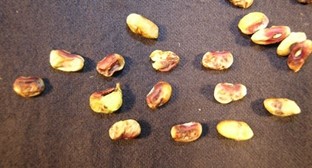Disease Notes
Contact
Plant Diagnostician
Phone: (479) 575-2727
Email: ssmith@uada.edu
Jason Pavel
Diagnostician
Phone: (479) 575-7257
Email: jpavel@uada.edu
University of Arkansas System Division of Agriculture
Cralley Warren Building
Room 16
2601 N. Young Ave.
Fayetteville, AR 72704
Field Pea Pests
Sherrie Smith and Jason Pavel
Plant Health Clinic Disease Note: Issue 32
Field Peas (Southern Peas, Black- eyed Peas, Cowpeas)
Stink Bugs can cause serious damage to Southern Peas by puncturing the pods to feed on developing beans. Research has shown that one adult stink bug can damage up to 59 seeds.
The seeds become malformed, shriveled, and distorted, with puncture marks clearly visible. See image below of cowpea stinkbug damage (Family Pentatomidae), courtesy of Sherrie Smith, UA Plant Pathologist.

Cowpea Curculio (see image below) can cause similar symptoms. Read more about pea production in our fact sheet.
However, Curculios lay their eggs inside feeding wounds which hatch into small larvae. The larvae feed on several of the seeds before boring a hole through the pod wall to escape and pupate in the ground. Stink Bugs lay eggs on the undersides of leaves and on stems. Stink Bug eggs hatch into nymphs that look like small bugs. Stink Bug nymphs do not develop inside the pods. Flail mowing prior to pod set can prevent Stink Bug outbreaks.
The image below courtesy of Sherrie Smith, shows cowpea curculio (Chalcodermus aeneus), where larvae have emerged from a cowpea.

Thiodan, Karate Z, and Mustang Max are labeled for both Stink Bugs and Cowpea Curculio. Insecticides should be applied when 2 Stink Bugs per 10 row feet are found. Curculio control should begin when pods are ½” long and continue at 5-day intervals. Follow label for specific intervals.
Take Aways
- Scout early for stinkbugs and apply insecticides if two or more are found per 10 row ft.
- Begin curculio insecticides when pods reach ½ inch long.
This work is supported by the Crop Protection and Pest Management Program [grant no. 2017-70006- 27279/project accession no. 1013890] from the USDA National Institute of Food and Agriculture.